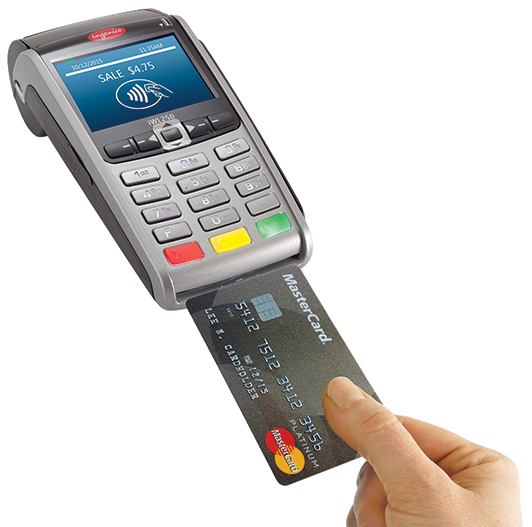|
Technology
Fraud Protection
Compliance technology and the jewelry industry’s slow march toward progress.
By Lara Ewen
 | | Photo courtesy Mastercard. |
In October 2015, U.S. payment networks shifted liability for credit card fraud to whichever party was using the lesser technology, for example, magnetic stripes instead of EMV chips. That's because EMV chips — the acronym stands for Europay, MasterCard and Visa — are designed to lower the possibility of fraud. As technology advances, reducing that risk is more complicated and more important that ever. Beth Kitchener, business leader, North America communications, for Purchase, New York–based credit card company MasterCard, explains, “If fraud results from a magnetic stripe card being swiped in a chip-enabled terminal, the issuing bank is responsible for the fraud. And vice versa.” Kitchener continues, “Counterfeit fraud costs increased by 77 percent year-over-year among U.S. merchants who have not yet or have just begun the migration to chip.” This means it’s time for the jewelry industry to adopt EMV terminals as quickly as possible. And yet it’s been over a year, and independent jewelry stores are still dragging their collective heels in terms of updating their credit card machines. That’s bad business. Shifting to EMV-enabled terminals is especially important for jewelry stores. “Companies that have higher volumes to sell should be more likely to adopt EMV because liability shift goes to the merchant,” says George Peabody, partner at Menlo Park, California–based management consulting firm Glenbrook Partners. “If you’re a little company, it’s not a big deal, but if you’re selling a $1,000 piece of jewelry, that’s a bigger deal. Jewelers in particular should be rushing to have EMV, because fraud loss, to them, is really meaningful.” However, terminals, which generally run between $400 and $1,000, are not always readily available. “Our recently released survey shows that there’s a queue for the EMV hardware, and there’s a waiting line because of that rush,” says Jared Drieling, business intelligence manager at Omaha, Nebraska–based management consulting company The Strawhecker Group (TSG), which focuses on the global electronic payments industry. “The second hurdle, the biggest, is that once merchants get their hands on that terminal, they’re thrown into another queue to get it activated.” This slow process has been frustrating for merchants, but has also given rise to newer, tablet-based terminals, such as those from Revel Systems, ShopKeep and Clover. “Jewelry stores, especially small, independent stores, are already prime targets for credit card fraud,” said Mark Schulze, co-founder of Mountain View, California–based Clover. The point-of-sale platform is owned by First Data Corporation, a global payment technology company headquartered in Atlanta, Georgia. Schulze, whose low-profile tablet-based terminals are becoming more popular, believes it’s as much about aesthetics as it is about security. “Aesthetics play a huge role in everything that goes into a jewelry store,” he says. Regardless of which EMV-terminal a store opts for, it’s crucial to begin the process immediately. “Jewelry stores need to put plans in place and make this decision,” says Drieling. “The queue should lighten up in early 2017, so you need to be in the queue right now.” Drieling says he can’t overstate the importance of updating. “In this industry, one bad case of fraud could move the needle from being open to being shut down,” he says.Article from the Rapaport Magazine - November 2016. To subscribe click here.
|
|